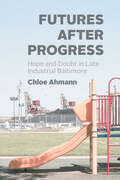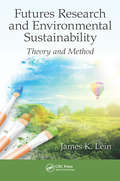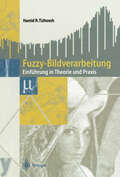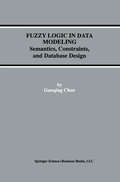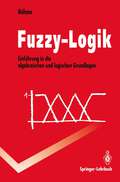- Table View
- List View
Futures after Progress: Hope and Doubt in Late Industrial Baltimore
by Chloe AhmannA powerful ethnographic study of South Baltimore, a place haunted by toxic pasts in its pursuit of better futures. Factory fires, chemical explosions, and aerial pollutants have inexorably shaped South Baltimore into one of the most polluted places in the country. In Futures after Progress, anthropologist Chloe Ahmann explores the rise and fall of industrial lifeways on this edge of the city and the uncertainties that linger in their wake. Writing from the community of Curtis Bay, where two hundred years of technocratic hubris have carried lethal costs, Ahmann also follows local efforts to realize a good future after industry and the rifts competing visions opened between neighbors. Examining tensions between White and Black residents, environmental activists and industrial enthusiasts, local elders and younger generations, Ahmann shows how this community has become a battleground for competing political futures whose stakes reverberate beyond its six square miles in a present after progress has lost steam. And yet—as one young resident explains—“that’s not how the story ends.” Rigorous and moving, Futures after Progress probes the deep roots of our ecological predicament, offering insight into what lies ahead for a country beset by dreams deferred and a planet on the precipice of change.
Futures: Imagining Socioecological Transformation
by Bruce BraunFutures: Imagining Socioecological Transformation brings together leading scholars to explore how we might know, enact, and struggle for, the conjoined social and ecological transformations we need to achieve just and sustainable futures. The question of transformation, and how it might be achieved, is explored across a variety of topics and geographical sites, and through heterodox analytical and theoretical approaches, in a collective effort to move beyond a form of critique that hands down judgements, to one that brings new ideas and new possibilities to life. Chapters are lively and original engagements with concrete situations that sparkle with creativity. Together, they add up to an impressive study of how to live, and what to struggle for, in the complex socioecological landscapes of the Anthropocene. This book was previously published as a special issue of the Annals of the Association of American Geographers.
Futures: Imagining Socioecological Transformation
by Bruce Willems-BraunFutures: Imagining Socioecological Transformation brings together leading scholars to explore how we might know, enact, and struggle for, the conjoined social and ecological transformations we need to achieve just and sustainable futures. The question of transformation, and how it might be achieved, is explored across a variety of topics and geographical sites, and through heterodox analytical and theoretical approaches, in a collective effort to move beyond a form of critique that hands down judgements, to one that brings new ideas and new possibilities to life. Chapters are lively and original engagements with concrete situations that sparkle with creativity. Together, they add up to an impressive study of how to live, and what to struggle for, in the complex socioecological landscapes of the Anthropocene. This book was previously published as a special issue of the Annals of the Association of American Geographers.
Futures Research and Environmental Sustainability: Theory and Method
by James K. LeinThis book explores the challenges of presenting sustainability as a more actionable or practical concept and identifying approaches that might offer useful assistance in addressing the temporal and spatial representation of sustainability. The underlying premise of this book is that sustainability is a state realized in the future. In that future there is a geographic arrangement of society and economy that agrees with its environmental setting. This future perspective introduces a little examined subject area that can lend significant content to the sustainability challenge: Futures Research.
Futures Research and Environmental Sustainability: Theory and Method
by James K. LeinThis book explores the challenges of presenting sustainability as a more actionable or practical concept and identifying approaches that might offer useful assistance in addressing the temporal and spatial representation of sustainability. The underlying premise of this book is that sustainability is a state realized in the future. In that future there is a geographic arrangement of society and economy that agrees with its environmental setting. This future perspective introduces a little examined subject area that can lend significant content to the sustainability challenge: Futures Research.
Futurize! Dealing with Megatrends and Disruptors: A Handbook for the Future-Oriented CEO
by André de Waal Julie LinthorstThe future will bring only more megatrends and disruptions. With the guidance of this book, which centers around the authors’ years-of-research-backed high-performance organizations (HPO) framework and includes the unique self-assessment tool Futurize! Diagnosis, business leaders and organizations will be prepared and truly ‘future ready.’ The next two decades will present massive challenges for organizations, as they navigate the need for sustainable development against a complex backdrop of factors such as increasing inequality, resource scarcity, continued globalization, and the ever-increasing speed of technological advancement. This book will help business leaders and organizations set priorities and make decisions so that not only do they honor commitments to the United Nations Sustainable Development Goals, but also become more future ready by: identifying the megatrends and disruptors which impact organizations now and will in the future specifically outlining how those megatrends and disruptors will impact organizations showing how organizations can deal with this impact in practical terms. This book is a must for management teams, aspiring leaders, and professionals and students interested in the future of work, human resource management, and innovation.
Futurize! Dealing with Megatrends and Disruptors: A Handbook for the Future-Oriented CEO
by André de Waal Julie LinthorstThe future will bring only more megatrends and disruptions. With the guidance of this book, which centers around the authors’ years-of-research-backed high-performance organizations (HPO) framework and includes the unique self-assessment tool Futurize! Diagnosis, business leaders and organizations will be prepared and truly ‘future ready.’ The next two decades will present massive challenges for organizations, as they navigate the need for sustainable development against a complex backdrop of factors such as increasing inequality, resource scarcity, continued globalization, and the ever-increasing speed of technological advancement. This book will help business leaders and organizations set priorities and make decisions so that not only do they honor commitments to the United Nations Sustainable Development Goals, but also become more future ready by: identifying the megatrends and disruptors which impact organizations now and will in the future specifically outlining how those megatrends and disruptors will impact organizations showing how organizations can deal with this impact in practical terms. This book is a must for management teams, aspiring leaders, and professionals and students interested in the future of work, human resource management, and innovation.
Fuzzy-Bildverarbeitung: Einführung in Theorie und Praxis
by Hamid R. TizhooshIn den letzten Jahren hat die Fuzzy-Logik auch im Bereich der Mustererkennung Einzug gehalten. Das Buch befaßt sich mit dem Einsatz von Fuzzy-Methoden in der digitalen Bildverarbeitung. Es führt Schritt für Schritt in die Theorie und Praxis der Fuzzy-Bildverarbeitung ein und stellt neue Konzepte, Definitionen und Algorithmen vor. Anhand zahlreicher Beispiele wird die Theorie unmittelbar in die Praxis umgesetzt.Das Buch wendet sich an alle Wissenschaftler, Ingenieure und Studierenden, die in den Bereichen der Fuzzy-Logik oder der Bildverarbeitung aktiv sind. Vorausgesetzt wird nur eine gewisse Vertrautheit mit Bildverarbeitung; die Grundlagen der Fuzzy-Logik werden in den ersten Kapiteln ausführlich behandelt.
Fuzzy Logic and its Applications to Engineering, Information Sciences, and Intelligent Systems (Theory and Decision Library D: #16)
by Zeungnam Bien K. C. MinFuzzy technology has emerged as one of the most exciting new concepts available. Fuzzy Logic and its Applications... covers a wide range of the theory and applications of fuzzy logic and related systems, including industrial applications of fuzzy technology, implementing human intelligence in machines and systems. There are four main themes: intelligent systems, engineering, mathematical foundations, and information sciences. Both academics and the technical community will learn how and why fuzzy logic is appreciated in the conceptual, design and manufacturing stages of intelligent systems, gaining an improved understanding of the basic science and the foundations of human reasoning.
Fuzzy Logic Foundations and Industrial Applications (International Series in Intelligent Technologies #8)
by Da RuanFuzzy Logic Foundations and Industrial Applications is an organized edited collection of contributed chapters covering basic fuzzy logic theory, fuzzy linear programming, and applications. Special emphasis has been given to coverage of recent research results, and to industrial applications of fuzzy logic. The chapters are new works that have been written exclusively for this book by many of the leading and prominent researchers (such as Ronald Yager, Ellen Hisdal, Etienne Kerre, and others) in this field. The contributions are original and each chapter is self-contained. The authors have been careful to indicate direct links between fuzzy set theory and its industrial applications. Fuzzy Logic Foundations and Industrial Applications is an invaluable work that provides researchers and industrial engineers with up-to-date coverage of new results on fuzzy logic and relates these results to their industrial use.
Fuzzy Logic in Data Modeling: Semantics, Constraints, and Database Design (Advances in Database Systems #15)
by Guoqing Chenalso in: THE KLUWER INTERNATIONAL SERIES ON ASIAN STUDIES IN COMPUTER AND INFORMATION SCIENCE, Volume 2
Fuzzy-Logik: Einführung in die algebraischen und logischen Grundlagen (Springer-Lehrbuch)
by Gert BöhmeDer Begriff "Fuzzy" - 1965 von Lofty A. Zadeh in einer Erweiterung der gewöhnlichen Mengenlehre auf die Verknüpfung unscharfer Mengen kreiert - hat seine Anwendung in zahlreichen Gebieten der Technik gefunden. In diesem Lehrbuch erhält der Leser eine leicht verständliche Einführung in die mathematischen und logischen Grundlagen. Er soll in die Lage versetzt werden, die für die Fuzzy-Logik spezifischen algebraischen und logischen Arbeitsmethoden operativ einzusetzen. Das Lehrbuch wurde mit dem Ziel entwickelt, insbesondere im Selbststudium das Werkzeug "Fuzzy" für die berufspraktische Anwendung zu erarbeiten. Zu diesem Zweck enthält es eine große Anzahl von Beispielen aus der Anwendung sowie Aufgaben mit Lösungen. Fuzzy-Logik wendet sich gleichermaßen an Studenten der Ingenieurwissenschaften, Informatik und Wirtschaftswissenschaften, wie auch an Anwender in der industriellen Praxis, die sich in dieses aktuelle und hochbrisante Gebiet einarbeiten möchten.
Fuzzy Modeling with Spatial Information for Geographic Problems
by Frederick E. Petry Vincent B. Robinson Maria A. CobbThe capabilities of modern technology are rapidly increasing, spurred on to a large extent by the tremendous advances in communications and computing. Automated vehicles and global wireless connections are some examples of these advances. In order to take advantage of such enhanced capabilities, our need to model and manipulate our knowledge of the geophysical world, using compatible representations, is also rapidly increasing. In response to this one fundamental issue of great concern in modern geographical research is how to most effectively capture the physical world around us in systems like geographical information systems (GIS). Making this task even more challenging is the fact that uncertainty plays a pervasive role in the representation, analysis and use of geospatial information. The types of uncertainty that appear in geospatial information systems are not the just simple randomness of observation, as in weather data, but are manifested in many other forms including imprecision, incompleteness and granularization. Describing the uncertainty of the boundaries of deserts and mountains clearly require different tools than those provided by probability theory. The multiplicity of modalities of uncertainty appearing in GIS requires a variety of formalisms to model these uncertainties. In light of this it is natural that fuzzy set theory has become a topic of intensive interest in many areas of geographical research and applications This volume, Fuzzy Modeling with Spatial Information for Geographic Problems, provides many stimulating examples of advances in geographical research based on approaches using fuzzy sets and related technologies.
Fuzzy Networks for Complex Systems: A Modular Rule Base Approach (Studies in Fuzziness and Soft Computing #259)
by Alexander GegovThis book introduces the novel concept of a fuzzy network whose nodes are rule bases and the connections between the nodes are the interactions between the rule bases in the form of outputs fed as inputs. The concept is presented as a systematic study for improving the feasibility and transparency of fuzzy models by means of modular rule bases whereby the model accuracy and efficiency can be optimised in a flexible way. The study uses an effective approach for fuzzy rule based modelling of complex systems that are characterised by attributes such as nonlinearity, uncertainty, dimensionality and structure.The approach is illustrated by formal models for fuzzy networks, basic and advanced operations on network nodes, properties of operations, feedforward and feedback fuzzy networks as well as evaluation of fuzzy networks. The results are demonstrated by numerous examples, two case studies and software programmes within the Matlab environment that implement some of the theoretical methods from the book. The book shows the novel concept of a fuzzy network with networked rule bases as a bridge between the existing concepts of a standard fuzzy system with a single rule base and a hierarchical fuzzy system with multiple rule bases.
Fuzzy Reasoning in Information, Decision and Control Systems (Intelligent Systems, Control and Automation: Science and Engineering #11)
by S. G. Tzafestas Anastasios N. VenetsanopoulosGreat progresses have been made in the application of fuzzy set theory and fuzzy logic. Most remarkable area of application is 'fuzzy control', where fuzzy logic was first applied to plant control systems and its use is expanding to consumer products. Most of fuzzy control systems uses fuzzy inference with max-min or max-product composition, similar to the algorithm that first used by Mamdani in 1970s. Some algorithms are developed to refine fuzzy controls systems but the main part of algorithm stays the same. Triggered by the success of fuzzy control systems, other ways of applying fuzzy set theory are also investigated. They are usually referred to as 'fuzzy expert sys tems', and their purpose are to combine the idea of fuzzy theory with AI based approach toward knowledge processing. These approaches can be more generally viewed as 'fuzzy information processing', that is to bring fuzzy idea into informa tion processing systems.
Fuzzy Set Theory and Advanced Mathematical Applications (International Series in Intelligent Technologies #4)
by Da Da RuanFuzzy Set Theory and Advanced Mathematical Applications contains contributions by many of the leading experts in the field, including coverage of the mathematical foundations of the theory, decision making and systems science, and recent developments in fuzzy neural control. The book supplies a readable, practical toolkit with a clear introduction to fuzzy set theory and its evolution in mathematics and new results on foundations of fuzzy set theory, decision making and systems science, and fuzzy control and neural systems. Each chapter is self-contained, providing up-to-date coverage of its subject. Audience: An important reference work for university students, and researchers and engineers working in both industrial and academic settings.
Fuzzy Systems Modeling in Environmental and Health Risk Assessment (Water Resources Monograph)
by Ashok Deshpande Rehan Sadiq Boris FaybishenkoFuzzy Systems Modeling in Environmental and Health Risk Assessment Demonstrates the successful application of fuzzy systems modeling to real-world environmental and health problems In Fuzzy Systems Modeling in Environmental and Health Risk Assessment, a team of distinguished researchers delivers an up-to-date collection of the most successful and innovative attempts to apply fuzzy logic to problems involving environmental risk assessment, healthcare decision-making, the management of water distribution networks, and the optimization of water treatment and waste management systems. By explaining both the theoretical and practical aspects of using fuzzy systems modeling methods to solve complex problems, analyze risks and optimize system performance, this handy guide maintains a strongly application-oriented perspective throughout, offering readers a practical treatment of a cutting-edge subject. Readers will also find: Comprehensive explorations of the practical applications of fuzzy systems modeling in environmental science Practical advice on environmental quality assessments and human health risk analyses In-depth case studies involving air and water pollution, solid waste, indoor swimming pool and landfill risk assessments, wastewater treatment, and more Perfect for environmental engineers and scientists, Fuzzy Systems Modeling in Environmental and Health Risk Assessment will also benefit policy makers, computer scientists, mathematicians, and researchers and practitioners interested in applying soft computing theories to environmental problems.
Fuzzy Systems Modeling in Environmental and Health Risk Assessment (Water Resources Monograph)
by Boris Faybishenko Rehan Sadiq Ashok DeshpandeFuzzy Systems Modeling in Environmental and Health Risk Assessment Demonstrates the successful application of fuzzy systems modeling to real-world environmental and health problems In Fuzzy Systems Modeling in Environmental and Health Risk Assessment, a team of distinguished researchers delivers an up-to-date collection of the most successful and innovative attempts to apply fuzzy logic to problems involving environmental risk assessment, healthcare decision-making, the management of water distribution networks, and the optimization of water treatment and waste management systems. By explaining both the theoretical and practical aspects of using fuzzy systems modeling methods to solve complex problems, analyze risks and optimize system performance, this handy guide maintains a strongly application-oriented perspective throughout, offering readers a practical treatment of a cutting-edge subject. Readers will also find: Comprehensive explorations of the practical applications of fuzzy systems modeling in environmental science Practical advice on environmental quality assessments and human health risk analyses In-depth case studies involving air and water pollution, solid waste, indoor swimming pool and landfill risk assessments, wastewater treatment, and more Perfect for environmental engineers and scientists, Fuzzy Systems Modeling in Environmental and Health Risk Assessment will also benefit policy makers, computer scientists, mathematicians, and researchers and practitioners interested in applying soft computing theories to environmental problems.
Gaelic Scotland: The Transformation of a Culture Region (Routledge Library Editions: Human Geography)
by Charles W WithersThis book, originally published in 1988, examines the Highlands and Islands of Scotland over several centuries and charts their cultural transformation from a separate region into one where the processes of anglicisation have largely succeeded. It analyses the many aspects of change including the policies of successive governments, the decline of the Gaelic language, the depressing of much of the population into peasantry and the clearances.
Gaelic Scotland: The Transformation of a Culture Region (Routledge Library Editions: Human Geography #19)
by Charles W WithersThis book, originally published in 1988, examines the Highlands and Islands of Scotland over several centuries and charts their cultural transformation from a separate region into one where the processes of anglicisation have largely succeeded. It analyses the many aspects of change including the policies of successive governments, the decline of the Gaelic language, the depressing of much of the population into peasantry and the clearances.
Gaia: A New Look at Life on Earth (The Macat Library)
by Mohammad ShamsudduhaGaia: A New Look At Life on Earth may continue to divide opinion, but nobody can deny that the book offers a powerful insight into the creative thinking of its author, James E. Lovelock. Published in 1979, Gaia offered a radically new hypothesis: the Earth, Lovelock argued, is a living entity. Together, the planet and all its separate living organisms form a single self-regulating body, sustaining life and helping it evolve through time. Lovelock sees humans as no more special than other elements of the planet, railing against the once widely-held belief that the good of mankind is the only thing that matters. Despite being seen as radical, and even idiotic on its publication, a version of Lovelock’s viewpoint has found resonance in contemporary debates about the environment and climate, and has now broadly come to be accepted by modern thinkers. As man’s effects on the climate become increasingly extreme, more and more elements of the Earth’s self-regulation seem to be unveiled – forcing scientists to ask how far the planet might be able to go in order self-regulate effectively. Indeed, despite its far-fetched elements, Lovelock’s Gaia thesis seems to ring more convincingly today than ever before; that it does is largely a result of the critical thinking skills that allowed Lovelock to produce novel explanations for existing evidence and, above all, to connect existing fragments of evidence together in new ways.
Gaia: A New Look at Life on Earth (The Macat Library)
by Mohammad ShamsudduhaGaia: A New Look At Life on Earth may continue to divide opinion, but nobody can deny that the book offers a powerful insight into the creative thinking of its author, James E. Lovelock. Published in 1979, Gaia offered a radically new hypothesis: the Earth, Lovelock argued, is a living entity. Together, the planet and all its separate living organisms form a single self-regulating body, sustaining life and helping it evolve through time. Lovelock sees humans as no more special than other elements of the planet, railing against the once widely-held belief that the good of mankind is the only thing that matters. Despite being seen as radical, and even idiotic on its publication, a version of Lovelock’s viewpoint has found resonance in contemporary debates about the environment and climate, and has now broadly come to be accepted by modern thinkers. As man’s effects on the climate become increasingly extreme, more and more elements of the Earth’s self-regulation seem to be unveiled – forcing scientists to ask how far the planet might be able to go in order self-regulate effectively. Indeed, despite its far-fetched elements, Lovelock’s Gaia thesis seems to ring more convincingly today than ever before; that it does is largely a result of the critical thinking skills that allowed Lovelock to produce novel explanations for existing evidence and, above all, to connect existing fragments of evidence together in new ways.
The Gaia Hypothesis: Science on a Pagan Planet (science.culture)
by Michael RuseIn 1965 English scientist James Lovelock had a flash of insight: the Earth is not just teeming with life; the Earth, in some sense, is life. He mulled this revolutionary idea over for several years, first with his close friend the novelist William Golding, and then in an extensive collaboration with the American scientist Lynn Margulis. In the early 1970s, he finally went public with the Gaia hypothesis, the idea that everything happens for an end: the good of planet Earth. Lovelock and Margulis were scorned by professional scientists, but the general public enthusiastically embraced Lovelock and his hypothesis. People joined Gaia groups; churches had Gaia services, sometimes with new music written especially for the occasion. There was a Gaia atlas, Gaia gardening, Gaia herbs, Gaia retreats, Gaia networking, and much more. And the range of enthusiasts was—and still is—broad. In The Gaia Hypothesis, philosopher Michael Ruse, with his characteristic clarity and wit, uses Gaia and its history, its supporters and detractors, to illuminate the nature of science itself. Gaia emerged in the 1960s, a decade when authority was questioned and status and dignity stood for nothing, but its story is much older. Ruse traces Gaia’s connection to Plato and a long history of goal-directed and holistic—or organicist—thinking and explains why Lovelock and Margulis’s peers rejected it as pseudoscience. But Ruse also shows why the project was a success. He argues that Lovelock and Margulis should be commended for giving philosophy firm scientific basis and for provoking important scientific discussion about the world as a whole, its homeostasis or—in this age of global environmental uncertainty—its lack thereof. Melding the world of science and technology with the world of feeling, mysticism, and religion, The Gaia Hypothesis will appeal to a broad range of readers, from students and scholars of the history and philosophy of science to anyone interested in New Age culture.
The Gaia Hypothesis: Science on a Pagan Planet (science.culture)
by Michael RuseIn 1965 English scientist James Lovelock had a flash of insight: the Earth is not just teeming with life; the Earth, in some sense, is life. He mulled this revolutionary idea over for several years, first with his close friend the novelist William Golding, and then in an extensive collaboration with the American scientist Lynn Margulis. In the early 1970s, he finally went public with the Gaia hypothesis, the idea that everything happens for an end: the good of planet Earth. Lovelock and Margulis were scorned by professional scientists, but the general public enthusiastically embraced Lovelock and his hypothesis. People joined Gaia groups; churches had Gaia services, sometimes with new music written especially for the occasion. There was a Gaia atlas, Gaia gardening, Gaia herbs, Gaia retreats, Gaia networking, and much more. And the range of enthusiasts was—and still is—broad. In The Gaia Hypothesis, philosopher Michael Ruse, with his characteristic clarity and wit, uses Gaia and its history, its supporters and detractors, to illuminate the nature of science itself. Gaia emerged in the 1960s, a decade when authority was questioned and status and dignity stood for nothing, but its story is much older. Ruse traces Gaia’s connection to Plato and a long history of goal-directed and holistic—or organicist—thinking and explains why Lovelock and Margulis’s peers rejected it as pseudoscience. But Ruse also shows why the project was a success. He argues that Lovelock and Margulis should be commended for giving philosophy firm scientific basis and for provoking important scientific discussion about the world as a whole, its homeostasis or—in this age of global environmental uncertainty—its lack thereof. Melding the world of science and technology with the world of feeling, mysticism, and religion, The Gaia Hypothesis will appeal to a broad range of readers, from students and scholars of the history and philosophy of science to anyone interested in New Age culture.
The Gaia Hypothesis: Science on a Pagan Planet (science.culture)
by Michael RuseIn 1965 English scientist James Lovelock had a flash of insight: the Earth is not just teeming with life; the Earth, in some sense, is life. He mulled this revolutionary idea over for several years, first with his close friend the novelist William Golding, and then in an extensive collaboration with the American scientist Lynn Margulis. In the early 1970s, he finally went public with the Gaia hypothesis, the idea that everything happens for an end: the good of planet Earth. Lovelock and Margulis were scorned by professional scientists, but the general public enthusiastically embraced Lovelock and his hypothesis. People joined Gaia groups; churches had Gaia services, sometimes with new music written especially for the occasion. There was a Gaia atlas, Gaia gardening, Gaia herbs, Gaia retreats, Gaia networking, and much more. And the range of enthusiasts was—and still is—broad. In The Gaia Hypothesis, philosopher Michael Ruse, with his characteristic clarity and wit, uses Gaia and its history, its supporters and detractors, to illuminate the nature of science itself. Gaia emerged in the 1960s, a decade when authority was questioned and status and dignity stood for nothing, but its story is much older. Ruse traces Gaia’s connection to Plato and a long history of goal-directed and holistic—or organicist—thinking and explains why Lovelock and Margulis’s peers rejected it as pseudoscience. But Ruse also shows why the project was a success. He argues that Lovelock and Margulis should be commended for giving philosophy firm scientific basis and for provoking important scientific discussion about the world as a whole, its homeostasis or—in this age of global environmental uncertainty—its lack thereof. Melding the world of science and technology with the world of feeling, mysticism, and religion, The Gaia Hypothesis will appeal to a broad range of readers, from students and scholars of the history and philosophy of science to anyone interested in New Age culture.
